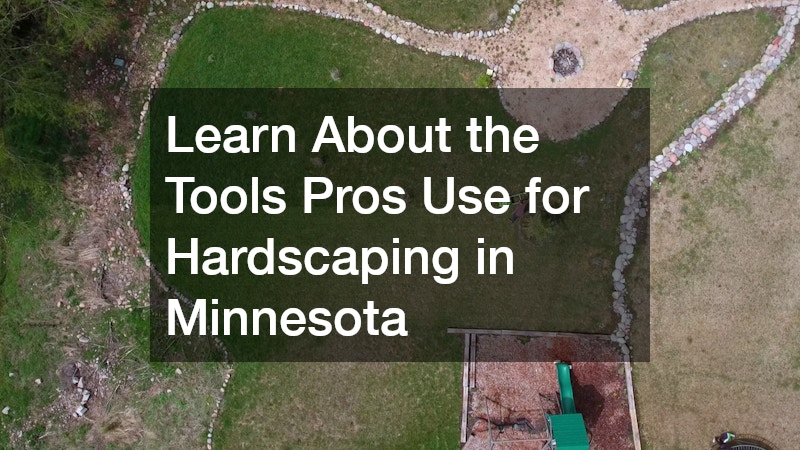
Hardscaping in Minnesota combines creativity with functionality, transforming outdoor spaces into visually appealing and practical landscapes. In Minnesota, where weather conditions can be extreme, understanding the tools that professionals use can provide insights into effective hardscaping practices tailored to the region.
What Are the Essential Tools for Hardscaping in Minnesota?
Professionals use a variety of tools to deal with the diverse challenges presented by Minnesota’s landscape and climate. Essential tools such as plate compactors, masonry saws, and laser levels are crucial in ensuring that materials like pavers and stones are securely set and level.
These tools provide the precision and strength needed to combat the unyielding Minnesota ground, which can become particularly challenging to work with during colder months.
Additionally, skid steers and mini excavators play a vital role in the preparation and installation phases of hardscaping. These powerful machines allow for efficient movement of earth and materials, significantly reducing the manual labor required. This is particularly important in Minnesota, where the soil can be dense and unforgiving. In conjunction with these machines, professionals often use trenchers to create necessary drainage solutions, combating the seasonal freeze-thaw cycles that can disrupt the stability of hardscaped areas.
Hand tools like tamps and block splitters also have a place in the hardscaper’s toolkit. These tools offer the fine-tuning and customization needed to handle intricate designs and smaller spaces. Given Minnesota’s intense climate variations, these tools help ensure that the finished landscape can withstand the elements and last for years. Together, this array of tools provides Minnesota professionals with the resources needed to execute projects that are as durable as they are beautiful.
How Do Professionals Adapt Hardscaping Techniques for Minnesota’s Climate?
The unique weather patterns in Minnesota require specific adaptations in hardscaping techniques. Professionals begin by assessing the site for factors such as soil type, drainage, and sunlight exposure, all of which can influence the choice of materials and techniques. Gravel bases and proper grading are often employed to encourage effective drainage, ensuring that water does not pool and freeze, which could damage the hardscape.
In Minnesota, the use of frost-resistant materials is critical. Professionals often select pavers and stones specifically designed to withstand frequent freeze-thaw cycles. Moreover, the installation process involves careful consideration of joint spacing and the use of polymeric sand. This sand locks in the pavers while allowing for slight movements that accommodate the ground’s natural shifts due to temperature changes.
Finally, professionals in Minnesota often incorporate thermal blankets or additives during concrete curing processes when working during colder months. This ensures that the materials set correctly and maintain their integrity. By adapting these techniques, hardscaping projects in Minnesota can achieve both aesthetic appeal and structural durability, vital in a state where weather extremes are the norm.
What Innovations Are Emerging in Hardscaping Tools for Cold Climates?
As technology advances, new tools and materials are continually being developed to enhance hardscaping efficiency and effectiveness. For instance, advances in GPS technology have made it easier for professionals to plan and execute projects with precision. These tools can help manage project logistics by ensuring that materials are delivered to the exact location, saving time and reducing errors.
Moreover, the development of new composite materials is making hardscaping in cold climates more flexible and sustainable. These materials can mimic the look of natural stone or wood while offering enhanced durability and resistance to temperature fluctuations. Additionally, eco-friendly solutions such as permeable pavers are gaining popularity, allowing for natural water absorption, reducing runoff, and decreasing the risk of freeze-related disruptions.
Battery-powered hand tools are another emerging trend, offering the same power and efficiency without the limitations of traditional fuel sources. These tools reduce emissions and offer quieter operation, which can be advantageous in residential areas. As these innovations continue to evolve, they open new possibilities for creating sophisticated, resilient landscapes across Minnesota and other cold climates.
Conclusion
Understanding the tools that professionals use for hardscaping in Minnesota offers valuable insights into the art and science of landscape design in challenging climates. By knowing the essential tools, adapting techniques, and staying aware of innovations, one can create stunning and resilient outdoor spaces that withstand the test of time. With the right equipment and knowledge, hardscaping professionals can transform Minnesota’s rugged landscape into projects of functional beauty that endure through all seasons.


